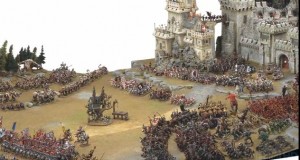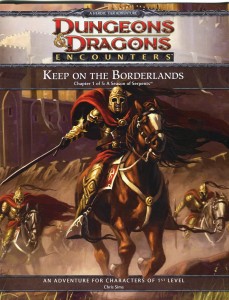Today marks our 500th post. When we’ve hit significant milestones at Dungeon’s Master in the past we’ve tried to relate the number of that milestone into that article. Our 100th post was a list of 100 Great Things About D&D. For our 300th post Wimwick and I each created King Leonidas from the movie 300. Post 404 was all about Errors I’ve Made as a DM. When I was trying to come up with a subject to tie in to our 500th post I kept thinking of the Fortune 500 – a list of the most wealthy and profitable companies in the U.S. From there it wasn’t much of a leap to start thinking about extreme wealth in D&D.
Tag: 4e

 The 2010 Hobby Show & The Great Canadian Game Show is happening this weekend in Toronto. It’s a showcase for many hobbies and games including, but not limited to, Dungeons & Dragons. If you live in the Greater Toronto Area or are a reasonable driving distance from here I strongly encourage you to check it out.
The 2010 Hobby Show & The Great Canadian Game Show is happening this weekend in Toronto. It’s a showcase for many hobbies and games including, but not limited to, Dungeons & Dragons. If you live in the Greater Toronto Area or are a reasonable driving distance from here I strongly encourage you to check it out.
The convention is happening at the International Centre in Mississauga, located at 6900 Airport Road and runs all weekend. Here are the hours of operation.
- Friday, November 5, 1 p.m. – 9 p.m.
- Saturday, November 6, 10 a.m. – 9 p.m.
- Sunday, November 7, 10 a.m. – 6 p.m.
Daily Admission is $12 for adults, $7 for children under 15 and free for kids 5 and under. For $2 off admission, just visit their website and print the coupon.
How important is alignment? Does it serve a practical purpose in D&D , or does it just take up room on the character sheet? The alignment mechanic underwent significant changes when 4e D&D was launched. The traditional or classic view of alignment was turned on its head. Nine alignments were pared down to only five; and two of the remaining alignments are, for the most part, off limits to players. So with only three real choices remaining does alignment even matter? Is this just a carryover from previous editions that no longer has a place in D&D?
As a player and a DM I believe that alignment is a vitally important part of every character sheet and that it doesn’t get nearly enough attention. In fact I’m extremely dissatisfied with how alignment is handled in 4e D&D.
Month in Review: October 2010
In October we returned to our roots and wrote about skill challenges… a lot. We looked at ways to make skill challenges more exciting and we provided new skill challenges for your campaign. We made sure that you knew what was going on with changes to LFR, provided an adventuring hook that generated a lot of discussion, looked back at the history of D&D computer games and forward to Neverwinter, and covered weeks 3-6 of D&D Encounters: Keep on the Borderlands.
Thanks to everyone who visited us during October and we hope that you keep visiting us in November. We welcome your feedback and appreciate it when you leave your comments. If you missed any of the great stuff we published in October then this is your chance to get caught up.
 One thing that I have never felt Dungeons & Dragons has handled well are large battles fought by armies. D&D gets the details down for one-on-one combat and small scale party based encounters. The mechanics are designed to accommodate these scenarios. Unfortunately, the rules that make small scale encounters fun simply don’t translate to larger battles.
One thing that I have never felt Dungeons & Dragons has handled well are large battles fought by armies. D&D gets the details down for one-on-one combat and small scale party based encounters. The mechanics are designed to accommodate these scenarios. Unfortunately, the rules that make small scale encounters fun simply don’t translate to larger battles.
Fortunately, these types of encounters are few and far between. Most adventurers spend their time in dungeons or completing quests that don’t require armies. However, every once in a while an army is needed. We can see examples of this when we consider the Lord of the Rings. For the majority of the tale the Fellowship journeys forth as a small group. It is only during a few climactic moments that large scale battle is called for.
 The show must to go on! Just because Ameron is on vacation is no excuse for Dungeon’s Master not to have a D&D Encounters weekly recap. I reached out to one of our loyal readers and he gratefully agreed to share his groups’ experiences with D&D Encounters week 6. Thanks to Rob Quinton (who you know as Lahrs, a frequent commenter at Dungeon’s Master) for his excellent summary of D&D Encounters week 6. Lahrs has been a player and a DM for the last twelve years and is currently running the D&D Encounters program at his FLGS.
The show must to go on! Just because Ameron is on vacation is no excuse for Dungeon’s Master not to have a D&D Encounters weekly recap. I reached out to one of our loyal readers and he gratefully agreed to share his groups’ experiences with D&D Encounters week 6. Thanks to Rob Quinton (who you know as Lahrs, a frequent commenter at Dungeon’s Master) for his excellent summary of D&D Encounters week 6. Lahrs has been a player and a DM for the last twelve years and is currently running the D&D Encounters program at his FLGS.
Putting Some Fairy In Your Tale
Fairy tales and folk lore provide great inspiration for Dungeons & Dragons. Most fantasy fiction borrows from what has come before it in some shape or form. It is only the rare work that is truly unique that redefines our expectations. When creating your adventures borrowing from fairy tales is a way to take something old and familiar, twist it, and use it against your players.
By now most players know, or should know, that a monster knowledge check can make all the difference when you’re fighting a monster for the very first time. Knowing that a monster is undead, has a vulnerability to fire or has a breath weapon will have a significant impact on what you do during the encounter. However, in practice I’ve discovered that making a monster knowledge check isn’t always as simple as rolling against the DCs set in the PHB. There are often other mitigating factors that need to be addressed when determining the success or failure of a monster knowledge check.
Any skill challenge that isn’t a challenge is boring. Here at Dungeon’s Master we’ve written a lot of articles about skill challenges. We’ve created a lot of skill challenge templates intentionally made generic enough that you can drop them right into an existing campaign. However, some skill challenges just aren’t that challenging to some parties. This is especially true as PCs get to higher levels. So what do you do if you find a skill challenge you want to use in your campaign but it’s not going to challenge your players? Simple, you make it more challenging – and we’ll tell you how.
Some DMs feel that skill challenges aren’t that malleable. They believe that skill challenges are designed with a certain level in mind and if you try to adjust the numbers for a party more than a couple of levels up or down it’s not going to work. I wholeheartedly disagree. With a little bit of creative thinking most skill challenge can be adapted to suit your party, regardless of the PCs’ current level.
 It looks like the LFR Global Admins have pretty much nailed how magic items will work after D&D Essentials becomes part of Living Forgotten Realms. Yesterday M. Sean Molley (posting as soccerref73) provided us with a preview in the article LFR Campaign Guide: Upcoming Magic Item Changes. Although the details are still not 100% finalized, this looks and sounds like a solid model and they pretty much say that in the article.
It looks like the LFR Global Admins have pretty much nailed how magic items will work after D&D Essentials becomes part of Living Forgotten Realms. Yesterday M. Sean Molley (posting as soccerref73) provided us with a preview in the article LFR Campaign Guide: Upcoming Magic Item Changes. Although the details are still not 100% finalized, this looks and sounds like a solid model and they pretty much say that in the article.
They’re never going to please everyone, but I think these changes sound fair and will please most of the people most of the time. They are still asking for your feedback so be sure to leave your comments. They’re especially concerned about gaps or loopholes that they might have missed.